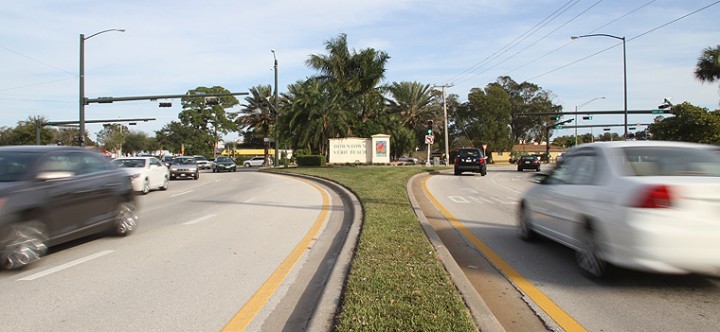
VERO BEACH — With only three of seven Planning and Zoning Board members in attendance Thursday afternoon, no vote was taken on how to proceed with plans to modify the State Road 60 split known as the “Twin Pairs.” Instead, the board heard more than 2 hours of comments from city staff, residents and business owners and agreed to pass the comments along to the Vero Beach City Council for further review.
Earlier this year, the city commissioned a feasibility study – funded through the Florida Department of Transportation and the Metropolitan Planning Organization – to determine what the impact would be if State Road 60’s westbound and eastbound split segments through downtown were narrowed to two lanes in each direction and accommodated on-street parallel parking.
“This will all lead to slowing the traffic down,” Vero Beach Planning and Development Director Tim McGarry told the board, explaining that narrowing the travel lanes, adding on-street parking and establishing wider bike lanes would aid in calming the traffic between 20th Avenue and the railroad tracks.
The study estimates that the cost to simply restripe the seven total lanes of State Road 60 to show parking spots would be approximately $515,000.
Other options considered included either restriping and highlighting parking spots with colored pavement would cost $690,000, or restriping, using colored pavement and adding bump-outs (or “knuckles”) to intersections would cost $825,000.
Vero Beach Public Works Director Monte Falls said that if the city could hold off for about 7 or so years, the Florida Department of Transportation would be back to the city to repave and otherwise renovate SR60. The state department would then absorb the basic restriping project, leaving any additional improvements up to the city.
Dr. Robert Loewinger presented to the Planning and Zoning Board a petition of 146 signatures from residents who oppose changes to SR60. He expressed concerns that adding parallel parking on both sides to westbound SR60 could result in bottlenecks as drivers try to park on either side of the thru lanes.
He also questioned government spending money on a project he believes falls beyond the scope of “basic services” and wondered if the funds that would be used on the project couldn’t be put to better use elsewhere.
Instead of reconfiguring SR60’s eastbound and westbound splits, Dr. Loewinger and another speaker, Bob Webster, proposed the city investigate lowering the 40 mph speed limit through the downtown area during business hours, and providing better signage denoting public parking, establishing better pedestrian cross-walks.
“Apparently, this Twin Pairs idea has been around a while,” Webster said. “And it’s gotten to the point where it seems to be the only thing being taken seriously.”
Kathleen Prouty, a board member of the Main Street Vero Beach organization, told the planning board that their concerns about SR60 have more to do about safety than about parking.
“I take my life in my hands,” she said of trying to cross SR60 at 14th Avenue. She added that those who participate in the monthly gallery strolls must cross SR60 in order to reach many of the art galleries.
Terry Torres, a business owner and member of Main Street Vero Beach, discussed the safety concerns he has regarding SR60 as it is now.
Drivers have “come right through my window,” he said. “It’s not an imagined thing, the hazard. The hazard is real.”
Other businesses along the Twin Pairs also have experienced drivers plowing through their windows or walls.
Brian Good, of consulting firm Kimly-Horn and Associates, told the board that the company reviewed the accident data over the course of the last five years and found that none of the downtown intersections are in the Top 10 percent for collisions but they are either average or above average for crashes.
“They have their fair share,” Falls told the board.
At the end of the discussion, two of the three board members expressed support for moving the proposal forward to the Vero Beach City Council, noting that there are numerous steps still to be done before a final decision could be reached.
“This is an economic engine for our city, that if we don’t give it our best effort, we’re shortchanging ourselves, in a way, for our future,” said acting-chair Lawrence Lauffer. “Is this an investment we need to make?”
Fellow board member Honey Minuse said the plan is a “very, very good start to correcting” the problems on SR60. “I’m inclined to listen to the experts” on this.
Board member Mark Mucher disagreed and said he could not support the current plan. Instead, he would rather see westbound SR60 more closely resemble eastbound SR60 as it is now and add green space between the sidewalk and the traffic lanes.
“I can’t go along with two lanes,” he said.
The next step is for the Vero Beach City Council to discuss the matter and potentially send it on to the county’s MPO Technical Advisory Board and the MPO Citizens Advisory Board. At some point, the Florida Department of Transportation would be involved in the process as well.



